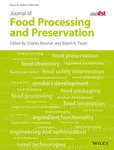Ultrasound-assisted extraction of anthocyanin from black rice bran using natural deep eutectic solvents: Optimization, diffusivity, and stability
Abstract
The present study was aimed to establish a green extraction method for anthocyanins from black rice bran using natural deep eutectic solvents (NADES) coupled with ultrasound-assisted extraction (UAE). Initially, five NADES were used and lactic acid: fructose was screened as an efficient extractant for anthocyanin from black rice bran. The extraction condition was optimized using an artificial neural network-genetic algorithm and the best condition was found to be time 11.25 min, water 12.63%, solvent-to-solid ratio 18.75 ml/g, amplitude 21.31%. The UAE-NADES extraction kinetics of anthocyanin was suitable for the pseudo second order model (0.94 ≤ R2 ≤ 0.99). The UAE-NADES showed higher effective diffusivity (1.14 × 10–12 m/s2) of anthocyanin than the conventional extraction process. The enthalpy, entropy, and Gibbs free energy were negative irrespective of temperature. The stability of anthocyanin in NADES was higher than aqueous medium. This result indicates that the proposed method is an excellent alternative for the extraction and stabilization of anthocyanin.
Practical applications
Anthocyanin pigments are used as food colorants, antioxidants, and anticancer agents. However, anthocyanin is sensitive to processing factors, and the majority of regularly used extractant solvents are hazardous to the environment and reduce anthocyanin stability. The present study demonstrated that using a natural deep eutectic solvent to extract anthocyanin minimizes pollutants, lowers expenses, and improves extraction efficiency. Moreover, the study also demonstrated the non-thermal extraction as well as valorization of black rice bran.
CONFLICT OF INTEREST
The author declares that there is no conflict of interest that could be perceived as prejudicing the impartiality of the research reported.
Open Research
DATA AVAILABILITY STATEMENT
The data that supports the findings of this study are available in the supplementary material of this article.




